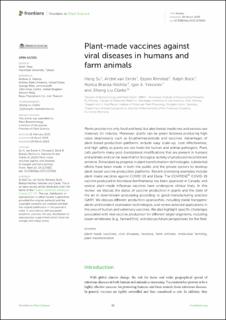| dc.contributor.author | Su, Hang | |
| dc.contributor.author | van Erde, André | |
| dc.contributor.author | Rimstad, Espen | |
| dc.contributor.author | Bock, Ralph | |
| dc.contributor.author | Branza-Nichita, Norica | |
| dc.contributor.author | Yakovlev, Igor | |
| dc.contributor.author | Liu Clarke, Jihong | |
| dc.date.accessioned | 2023-04-04T12:59:36Z | |
| dc.date.available | 2023-04-04T12:59:36Z | |
| dc.date.created | 2023-03-28T10:07:03Z | |
| dc.date.issued | 2023-03-28 | |
| dc.identifier.citation | Su, H., van Eerde, A., Rimstad, E., Bock, R., Branza-Nichita, N., Yakovlev, I. A., & Clarke, J. L. (2023). Plant-made vaccines against viral diseases in humans and farm animals. Frontiers in Plant Science, 14. | en_US |
| dc.identifier.issn | 1664-462X | |
| dc.identifier.uri | https://hdl.handle.net/11250/3062129 | |
| dc.description.abstract | Plants provide not only food and feed, but also herbal medicines and various raw materials for industry. Moreover, plants can be green factories producing high value bioproducts such as biopharmaceuticals and vaccines. Advantages of plant-based production platforms include easy scale-up, cost effectiveness, and high safety as plants are not hosts for human and animal pathogens. Plant cells perform many post-translational modifications that are present in humans and animals and can be essential for biological activity of produced recombinant proteins. Stimulated by progress in plant transformation technologies, substantial efforts have been made in both the public and the private sectors to develop plant-based vaccine production platforms. Recent promising examples include plant-made vaccines against COVID-19 and Ebola. The COVIFENZ® COVID-19 vaccine produced in Nicotiana benthamiana has been approved in Canada, and several plant-made influenza vaccines have undergone clinical trials. In this review, we discuss the status of vaccine production in plants and the state of the art in downstream processing according to good manufacturing practice (GMP). We discuss different production approaches, including stable transgenic plants and transient expression technologies, and review selected applications in the area of human and veterinary vaccines. We also highlight specific challenges associated with viral vaccine production for different target organisms, including lower vertebrates (e.g., farmed fish), and discuss future perspectives for the field. | en_US |
| dc.language.iso | eng | en_US |
| dc.publisher | Frontiers Media | en_US |
| dc.rights | Navngivelse 4.0 Internasjonal | * |
| dc.rights.uri | http://creativecommons.org/licenses/by/4.0/deed.no | * |
| dc.title | Plant-made vaccines against viral diseases in humans and farm animals | en_US |
| dc.title.alternative | Plant-made vaccines against viral diseases in humans and farm animals | en_US |
| dc.type | Peer reviewed | en_US |
| dc.type | Journal article | en_US |
| dc.description.version | publishedVersion | en_US |
| dc.rights.holder | © 2023 Su, van Eerde, Rimstad, Bock, Branza-Nichita, Yakovlev and Clarke | en_US |
| dc.source.volume | 14 | en_US |
| dc.source.journal | Frontiers in Plant Science | en_US |
| dc.identifier.doi | 10.3389/fpls.2023.1170815 | |
| dc.identifier.cristin | 2137471 | |
| dc.relation.project | EØS - Det europeiske økonomiske samarbeidsområde: 1SEE/2019 | en_US |
| dc.relation.project | NIBIO - Norsk institutt for bioøkonomi: 51133 | en_US |
| dc.relation.project | Norges forskningsråd: 319693 | en_US |
| dc.source.articlenumber | 1170815 | en_US |
| cristin.ispublished | true | |
| cristin.fulltext | original | |
| cristin.qualitycode | 2 | |

